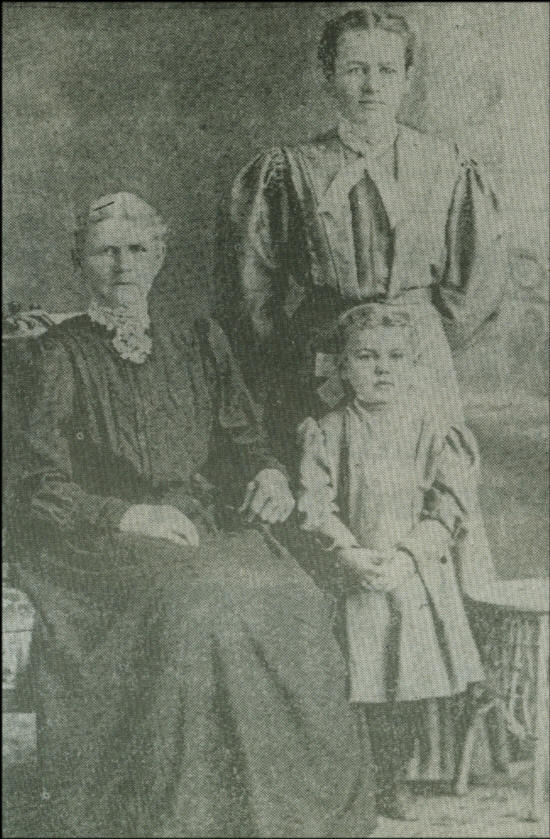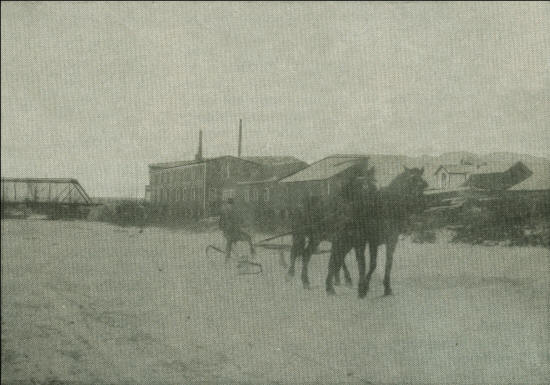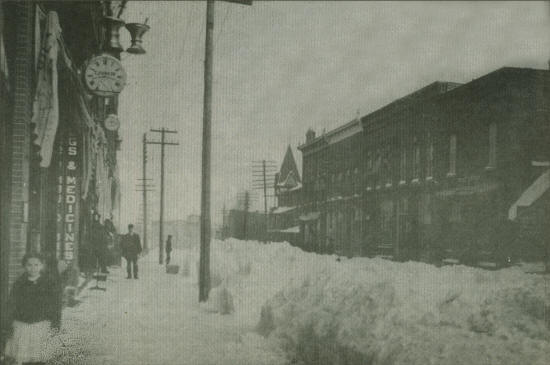|
|
|
Clark County Press, Neillsville, WI January 22, 1997, Page 28 Transcribed by Dolores (Mohr) Kenyon. Index of "Oldies" Articles |
|
|
|
Clark County Press, Neillsville, WI January 22, 1997, Page 28 Transcribed by Dolores (Mohr) Kenyon. Index of "Oldies" Articles |
In the Good Old Days
By Dee Zimmerman
Some of Clark County’s first residents were pioneers in the County’s farming industry. Many difficult and time staking tasks had to be endured before their goals were realized. Clearing the land so it could be tilled, obtaining livestock – all came slowly.
Among the very early families, the fifth to locate here, in 1854, was that of the Thomas Garvins. It was the year of the organization of Clark County and the vote over the location of the County seat.
Garvins, living on the west side of Black River, in the Town of Pine Valley, went through the first winter without owning a cow and not able to find one. There were three small children in the family and there was little or no milk or butter to give them.
The official assessment count gave Clark County more than 100,000 cattle in 1945, so it is difficult to understand how not one cow could be found to purchase in 1854,
The following spring Mrs. Garvin heard of a family that was moving away from the vicinity of Kurth’s corners. So she walked there to try to buy the cow. She wore a new shawl which had been given to her by her brother Robert Ross, an early logger, who had bought the shawl on a business trip in La Crosse.
When she arrived at the home of the departing family, covetous eyes fell upon that shawl. The owners of the cow would not sell for money, but they would trade for the shawl. Mrs. Garvin was reluctant to part with the shawl, a gift from her brother and which she needed for warmth. But when she remembered the long hard winter they had endured, without milk or butter for three children, she took off the shawl and handed it over. Then she led the cow home to the Garvin place, a walk of about seven miles. Their home was near the location of the first Black River west side train depot.
The Garvin family left the Neillsville area in 1902, settling in Seattle.
Another pioneering farm family took pride in establishing a highly productive diary herd. They claimed an “eleven generation” strain of cattle.
At about the turn of the century, Caroline Gerlach bought a Jersey cow and its heifer calf at Cash Eidis auction. Mrs. Gerlach sold the heifer to her daughter, Mrs. Amelia Davis, who raised an entire herd of cows from that heifer and her descendants. In 1943, five cows of that herd were passed on to family members.
McHones who developed a herd of 20 cows and heifers from that nucleus; McHone could trace eleven generations of cows back to the Jersey cow his great-grandmother owned.
Through the years, the breeding program picked up the Guernseys so that the Jersey characteristics had been lost. When the Neillsville Milk Products Co-operative first started operating, that herd of cows produced the highest testing milk received at the plant.
A pioneering dairy herd? Yes, that was a Clark County pioneer dairy herd established by a pioneering family.
 |
Caroline Gerlach, a hardy pioneer, accompanied her husband, Sam, coming to Clark County in 1870. As a couple they worked hard to establish a farmstead out of the wilderness. Caroline is shown in a long skirt characteristic of the turn of the century. At her right are her daughter Amelia (Davis) McHone and her granddaughter, Caroline McHone.
Sam and Caroline Gerlach were pioneers, finding on their arrival in Marshfield shortly after 1870, and only two buildings. Their first home in Clark County was carved from the wilderness, situated two miles south of Chili. They moved to a second farm on Pleasant Ridge, and then later moved to a farm site north of Granton.
While they farmed, wheat was an important crop. Flour was obtained by hauling your own wheat and rye to the mill, where toll was taken in payment for the grinding and you took home your own wheat and rye flour. Caroline Gerlach made barrels of sauerkraut to sell to the logging camps in the vicinity of Granton. Their sons shot partridges and shipped them on the train to the city, receiving 25 cents a-piece. The power for threshing was provided by driving teams of horses hitched to a sweep around and around in a circle all day.
Gerlachs bought the first grain binder in their neighborhood and for a number of years cut their neighbor’s grain as well as their own. In winter the cattle were driven to the creek where a hole was chopped in the ice, so that they might drink water.
Butter was churned in the home and was sold at the store in crocks or tubs. Bills were paid by a barter system with home cured hams, flour or loads of wood. The young men drove their girls to dances as far away as 20 or 25 miles with a team of horses that had pulled a plow or some other farm implement all day.
Life indeed was simple then. One dollar meant one dollar’s worth of security. Honesty was a virtue. A handshake between men sealed a deal and both would honor their agreement. Entertainment was homemade. A borrowed book was read in appreciation to the one who had loaned it.
Clark County Press – January 1937
Roy Montgomery of Neillsville, regional manager of Maytag Wringer Washing machines led all other representatives in Wisconsin during 1936; it was reported by the company in Newton, Iowa. Montgomery sold 1,780 Machines which equals 35 carloads or one trainload.
Judge E. N. Crosby was elected president of the newly organized Neillsville Rifle and Gun Club at a meeting in the Merchants Hotel Friday night. Other officers named were Ben Brown, Herbert Smith, James H. Fradette, F. E. Brown, Lewis Bradbury, Allen Covell and Elliott Warlum with Emil Mattson as range officer. The basement of the city hall is being utilized as a range.
F. D. Calway attended a meeting of the Conservation Commission at Black River Falls at which cranberry growers discussed the control of muskrats in cranberry marshes. Muskrats cause much damage to cranberry marshes and means of exempting the growers form the laws protecting muskrats are to be worked out. Calway has a large cranberry marsh west of Neillsville which will soon be in production.
Al Kreisch has taken over the Orchard Tavern east of Granton which he will operate until spring. In the spring, Kreisch plans to build an addition to the “House by the side of the Road” at the south end of Hewett Street.
At 7:30 p.m., New Years Eve, Hope Wildish, daughter of Mr. and Mrs. Allen Wildish and Lester Zasoba, son of Mr. and Mrs. Walter Zasoba were quietly married in a ceremony performed at the Methodist parsonage with Rev. E. P. Stone, reading the single ring ritual service. They were accompanied by Mr. and Mrs. Edward Hohmann.
The organization of the Clark County Electrification Co-operative, which has been going on under the direction of Wallace J. Landry, county agent, is now the largest unit of its kind in Wisconsin with more than 2,000 farmers signed up as members.
Many farmers, not now served by electric lines, have long felt the need of electricity and it is hoped the new Co-operative venture will make it possible for every farm in Clark County to enjoy this convenience at reasonable rates. Landry and his office are to be congratulated on their outstanding leadership in this work which places Clark County in the forefront of the entire state.
F. H. Capsular, Northern States Power Company manager, explained to the city council Tuesday night why the present street lights, cause radio interference when they burn out.
 |
Putting up ice on the O’Neill Creek circa 1900
The Neillsville Brewery used a large amount of ice for their business and the location was convenient.
 |
Snow banks of 1904 on Hewett Street, Neillsville, as viewed from the 5th Street intersection, looking north. The apothecary symbols of both drug stores and clocks designate jewelry store fronts. The right side of Hewett views the O’Neill House on far end of the street with former Post Office site at the first building that’s in the scene. The Republican Press newspaper and printing sign is posted on the side of the post office building. (Photo courtesy of the Clark County Jail Museum)
|
© Every submission is protected by the Digital Millennium Copyright Act of 1998.
Show your appreciation of this freely provided information by not copying it to any other site without our permission.
Become a Clark County History Buff
|
|
A site created and
maintained by the Clark County History Buffs
Webmasters: Leon Konieczny, Tanya Paschke, Janet & Stan Schwarze, James W. Sternitzky,
|